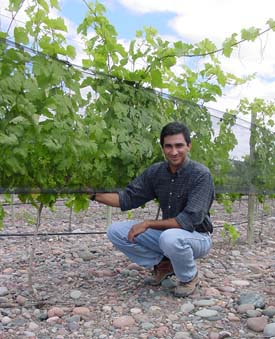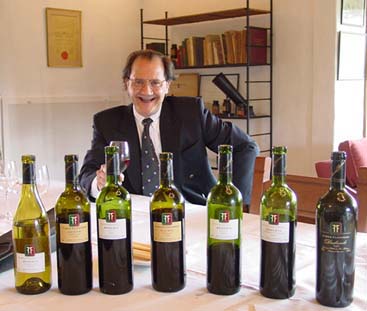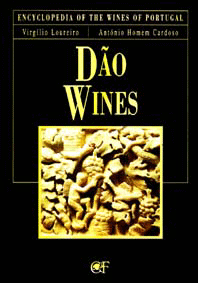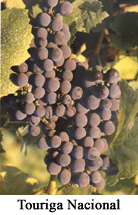Old World Meets New
From Portugal to Argentina
Sogrape Produces New World-Class Wines
©
Michael Vaughan 2002
National Post Weekly Wine & Spirits Columnist
National Post • Saturday, March 2, 2002
So
I am sitting in a Toronto wine bar surrounded by fashionable sippers from a
multitude of New World hot spots. I casually ask why Argentina and Portugal are not to be seen.
“They don’t move – nobody knows anything about them - people are
afraid to order them” was the answer.
What
a shame because both areas are producing great wines at terrific prices. It’s
incredible to think that Portugal’s wine laws were established by the Marquis
of Pombal in 1756, well before many of these now trendy regions even dreamt of
growing grapes.
One
of Portugal’s best red wine regions, Dão had established an international
reputation by the turn of the century. Located in north central Portugal, this beautiful undulating
region is sheltered by a series of mountain ranges that keep out the rainy
seaboard weather. The mineral laden
soils known as “horse’s tooth” consists of milky quartz, large crystals of
pink and gray feldspar and black mica – perfect for vines.
Historically,
this relatively densely populated rural area consisted of tens of thousands of
tiny impoverished growers where the average plot was a mere .14-hectare
(one-third of an acre). Wine-cellar
associations were always important in providing these small producers with an
outlet for their grapes. The iron
grip of government supported cooperatives reached a fever pitch by the 1970’s
when they were given exclusive rights to buy grapes.
This meant that private firms had to buy ready-made coop wines, a setback
that virtually killed the peaks of quality this region could produce.
It
wasn’t until 1989 that this restrictive legislation was overturned. Ironically
it was Sogrape, creator of the slightly
petillant Mateus Rosé, who built the remarkable
Quinta de Carvalhais, one of the most advanced wine-making centers in Europe in
the heart of the Dão. Production was based on nine indigenous grape varieties,
the most famous being Touriga Nacional.
Needless
to say, most consumers have never heard of these varieties and probably
couldn’t care less. And that is a
pity, because in a world of me-too-ism, it’s exciting to find wines with
delicious and yet distinctive flavours. Considering
that the Dão region has 50,000
acres (20,235 hectares) under vine, producing 5.5 million cases annually (80%
red and 20% white), a serious look is definitely in order.
 Without
question the place to start is the extremely tasty Sogrape
1999 Duque de Viseu,
which
is a LCBO
Vintages “Essential”
listing. It is also a bargain
reduced from its regular $13.65 to $10.95.
Unfortunately, this limited time offer (“LTO”)
ends today, so you will have to rush to bag this best buy. Without
question the place to start is the extremely tasty Sogrape
1999 Duque de Viseu,
which
is a LCBO
Vintages “Essential”
listing. It is also a bargain
reduced from its regular $13.65 to $10.95.
Unfortunately, this limited time offer (“LTO”)
ends today, so you will have to rush to bag this best buy.
As
for its taste, Sogrape’s winemaker Manuel Vieira has done wonders.
At one time, Dão was a hard, tannic, idiosyncratic tasting wine.
Today, there’s lots of juicy, ripe plumy fruit on the nose. On the palate, it’s medium bodied and dry but not austere
with spicy, rounded, ripe plum and black cherry flavours. A versatile,
wide-appeal, charmer, which is absolutely ready to drink.
Of
course the story could end here, except for one thing.
In December 1987, Sogrape made a major coup in acquiring Finca Flichman,
a major Argentine winery that was founded in Mendoza way back in 1873. Sogrape
poured a ton of money into the operation, completely restoring and updating the
old winery as well as extending the plantings on the 546-hectare site.
 Having
recently spent two weeks visiting more than two-dozen Mendoza vineyards, I can
tell you that no matter what happens to Argentine peso, their wines have a
fantastic potential. What bring
this all home it that Vintages will be releasing Finca
Flichman 1998 Reserva Syrah
in next Saturday’s release. At
only $14.95, it is without question the buy of the release. Having
recently spent two weeks visiting more than two-dozen Mendoza vineyards, I can
tell you that no matter what happens to Argentine peso, their wines have a
fantastic potential. What bring
this all home it that Vintages will be releasing Finca
Flichman 1998 Reserva Syrah
in next Saturday’s release. At
only $14.95, it is without question the buy of the release.
Deep
purple in colour, this 100% Syrah is very bright and well structured on the
palate with mouth filling sweet cocoa and slightly smoky, black cherry flavours.
Fortunately, Vintages has brought in 500 cases, so there should be lots to go
around unless buyers get a little piggy.
The
secret to this wine is the clones of Syrah planted in 1965 on the incredible,
pebble-driven “soils” that are adjacent to the winery.
Located in the Barrancas subregion of Maipú ecosystem, the smooth round
pebbles in this dry old Mendoza riverbed vineyard go down almost two feet.
This and the reduced yields result in concentrated flavours and high
alcohol (14.4%). To preserve fruit, only part went through malolactic
fermentation after which it was aged in American oak for 10 months.

Alejandro Quiroga, the chief grower at Flichman, with his
Syrah vines
There
is no question that at these prices, traditional Syrah producers are going to be
seriously challenged. “The key is knowing where to plant the vines,” explains
winemaker Rodriguez Villa. “We
recently planted another 64 hectares in the cooler higher altitude Tupungato
area which we feel will be better suited for Chardonnay and Sauvignon Blanc.”

Rodriguez Villa
It
pleases me that Flichman-owner Sogrape has done the right thing by refusing to
produce popular international varieties in Portugal where the indigenous
varieties have so much to offer. Now
all one has to do is give the consumers a good shake and make them aware of the
quality out there. Consider this:
the five now-unemployed investment bankers could have quietly transformed their
five bottles of rare French dinner wine into 6,702 bottles of Flichman 1998 Reserve Syrah and kept their
jobs.
To
see what’s coming up in next week Saturday’s March 9th Vintages
release: PRESS
HERE
If you subscribe
today
and you will get a $15
complimentary pass to the upcoming Toronto Wine & Cheese Show (March 22-24).
A Update on Dão
The
Dão lies in the north-central province of Beira on an undulating plateau,
approximately 500 meters above sea level. The region is protected by a series of
mountain ranges (serras) - Estrela
in the east (famous for the wonderful cheese by the same name) and Buçaco
in the west, which has been producing highly sought-after, extracty reds at the
Hotel Palace do Buçaco (the old hunting palace of the king of Portugal) for
over 100 years now.
The
region is dissected by a number of rivers, the most famous being the Dão.
Rainfall is high and seasonal (mostly falling in the cold autumn and winter
months), while the summers are hot and very dry.
Soils are poor and granitic. Some sixteen sub regions can be identified,
each having somewhat different climate and soils. These have recently been
broken down into six formal sub regions.
Dão
wine production was documented by Polibus in the second century AD as Roman
armies fought countless battles in this region.
The region was formally demarcated in 1908.
Starting in 1943, the co-operative winery movement saw 10 companies set
up which, to this day, still account for 47% of all Dão DOC wine. Keep in mind
that only one-third of the region’s 500,000 hectolitres produced are good
enough to be certified. Most of this declassified wine (70%) is produced by these ten
large coops.
It’s
ironic that Baga is still the region’s leading grape although it isn’t
legally permitted in Dão. Today DOC Dão can only be made from nine varieties.
An excellent chart of varieties permitted in Dão (as set out by
legislation in 1953, 1973 and 1985) is reproduced from the outstanding book Dão
Wines by Virgílio Loureiro and Antonio Homen Cardoso (published July
1993 and part of the Encyclopedia
of the Wines of Portugal). TO SEE THE CHART PRESS HERE

 A
recent, more exclusive designation has been developed - “DOC
Dão Nobre”, which relies on only
five varieties: Touriga Nacional, Alfrocheiro, Preto, Tinta Roriz, Jaen and
Refete grapes. In the past, it was the efforts of the few independent, large,
individual estate owners “Quintas” who were able to make their own wine and sold it in
bulk to respectable shippers. These efforts maintained the reputation of the
region’s wines in the face of a flood of vin
ordinaire. Of course, some
great Dão wines were produced prior to 1990 in the DOC
Colheita (vintage), Reserva and Garrafiera
range (Sogrape Grão Vasco and José Maria Fonseca leap to mind).
It was the the recent transformation from the late 1980’s, however,
that really triggered the transformation in quality.
Today there are 51 shippers, 31 producer-bottlers (these are the Quinta
wines) and 10 surviving co-operatives. A
recent, more exclusive designation has been developed - “DOC
Dão Nobre”, which relies on only
five varieties: Touriga Nacional, Alfrocheiro, Preto, Tinta Roriz, Jaen and
Refete grapes. In the past, it was the efforts of the few independent, large,
individual estate owners “Quintas” who were able to make their own wine and sold it in
bulk to respectable shippers. These efforts maintained the reputation of the
region’s wines in the face of a flood of vin
ordinaire. Of course, some
great Dão wines were produced prior to 1990 in the DOC
Colheita (vintage), Reserva and Garrafiera
range (Sogrape Grão Vasco and José Maria Fonseca leap to mind).
It was the the recent transformation from the late 1980’s, however,
that really triggered the transformation in quality.
Today there are 51 shippers, 31 producer-bottlers (these are the Quinta
wines) and 10 surviving co-operatives.
Sogrape Backgrounder
This
family business was founded in 1942 by Fernando Van Zeller Guedes,
who developed a unique and easily recognizable bottle for a slightly petillant
wine called Mateus
Rosé which for many years was the darling of consumers world wide.
Since
1986, Sogrape has focused on the development and diversification of its range of
products. Under the direction of Salvador
Guedes, grandson of the founder, they have maintained their exclusively
dedication to the production of wines made exclusively from Portuguese native
grape varieties.
As
the country’s largest producer/exporter, it has vineyards and wineries in the
major Portuguese wine-growing regions - Douro, Dão, Bairrada, Alentejo and
Vinho Verde. It has established
long-lasting and innovative contracts with local growers to assure a consistent
supply of high quality grapes.
Sogrape
recently purchased Ferreira,
one of the leading high quality producers of Port.
In the process, it also became the new owner of the facility producing
Portugal’s most-famous red table wine - Barca
Velha. In 1996 Sogrape also acquired Forrester
& Co. Port house, owner of the Offley
brand.
In
December 1987, Sogrape made a major coup in acquiring Finca Flichman, a major
Argentine winery that was founded in Mendoza way back in 1873.
|